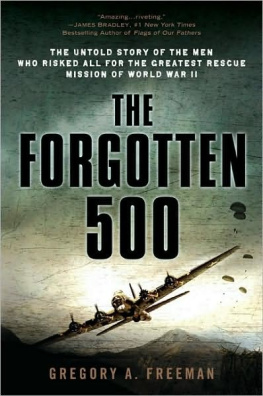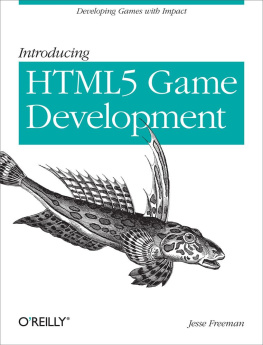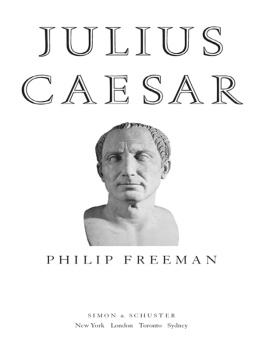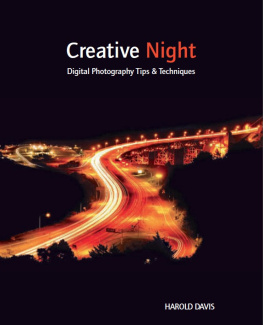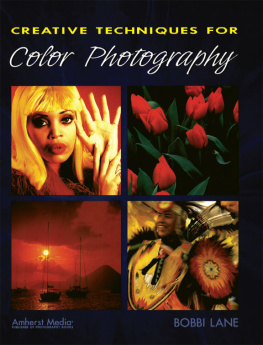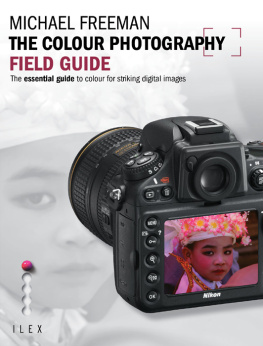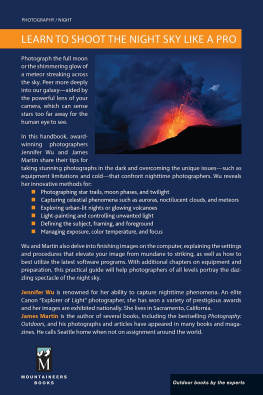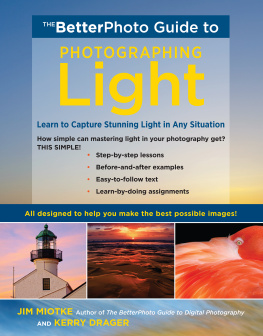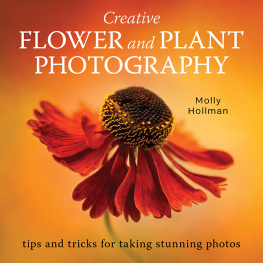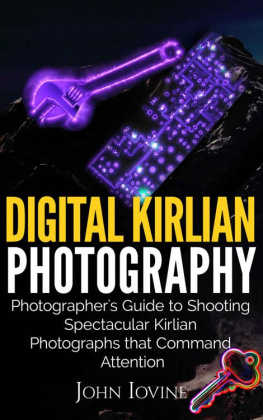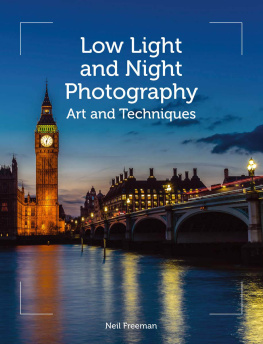
MICHAEL FREEMAN
THE LOW LIGHT PHOTOGRAPHY FIELD GUIDE

MICHAEL FREEMAN
THE LOW LIGHT PHOTOGRAPHY FIELD GUIDE
Go beyond daylight to capture stunning low light images

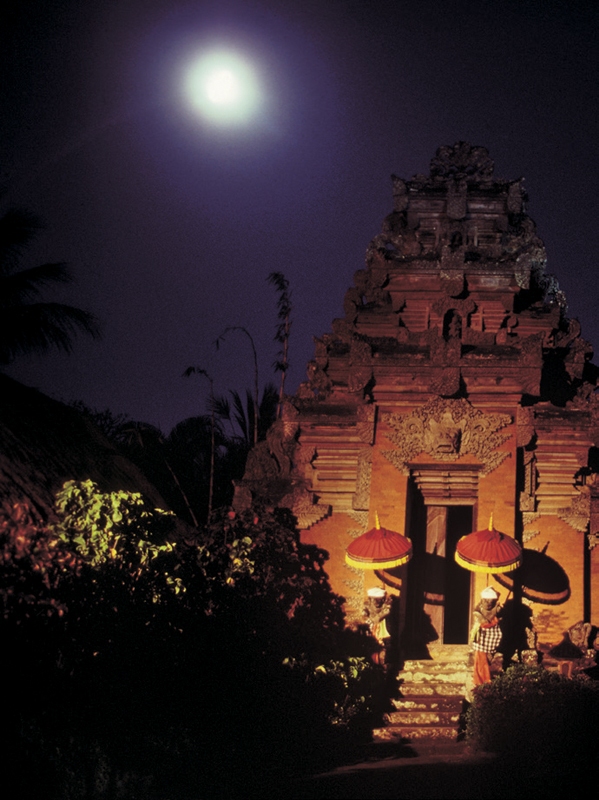
Focal Press is an imprint of Elsevier Inc.
225 Wyman Street, Waltham
MA 02451, USA
Copyright 2011 The Ilex Press Ltd.
All rights reserved
This book was conceived, designed, and produced by Ilex Press Limited 210 High Street, Lewes, BN7 2NS, UK
Publisher: Alastair Campbell
Creative Director: Peter Bridgewater
Associate Publisher: Adam Juniper
Managing Editor: Natalia Price-Cabrera and Zara Larcombe
Editorial Assistant: Tara Gallagher
Art Director: James Hollywell
Designer: Jon Allan
Color Origination: Ivy Press Reprographics
No part of this publication may be reproduced, stored in a retrieval system or transmitted in any form or by any means electronic, mechanical, photocopying, recording or otherwise without the prior written permission of the publisher.
Permissions may be sought directly from Elseviers Science & Technology Rights Department in Oxford, UK: Phone (+44) (0) 1865 843830; Fax (+44) (0) 1865 853333; Email: permissions@elsevier.com. Alternatively visit the Science and Technology Books website at www.elsevierdirect.com/rights for further information
Notice: No responsibility is assumed by the publisher for any injury and/or damage to persons or property as a matter of products liability, negligence or otherwise, or from any use or operation of any methods, products, instructions or ideas contained in the material herein.
Trademarks/Registered Trademarks: Brand names mentioned in this book are protected by their respective trademarks and are acknowledged.
Library of Congress Control Number: A catalog record for this book is available from the Library of Congress.
ISBN: 978-0-240-82080-4
For information on all Focal Press publications visit our website at:
www.focalpress.com
Printed and bound in China
10 11 12 13 14 5 4 3 2 1
CONTENTS
In previous books, by and large Ive divided the subject between shooting and post-production, a logical sequence that starts with the actual photography and moves through to the various ways of managing and optimizing images on the computer. The skills are different, as is the place and time, and so this makes sense.

LOW KEY
The cobbled plaza of the traditional colonial town of Villa de Leiva in Colombia helps lend atmosphere to this low-key, low-light photograph.
H ere, however, I deliberately mix post-production and computer work in with the shooting. Ive taken a conscious decision to do this because digital photography is no longer a new, high-tech version of old photography. For most photographers it is now photography, pure and simple. Moreover, I am also thinking about who the audience for this book is. Low light photography is specialized, and certainly more demanding technically than most other forms. I think it less likely that you will dive straight into this book as your first serious experience in photography than the more predictable route of exploring a new area having already mastered the basic techniques. Here I have stepped right over these basic techniques, and have skipped the primer stages of setting up the computer and familiarizing yourself with image editors such as Photoshop, and so on. For anyone expecting this, I apologize, but would direct them toward other volumes more suitable for beginners.
Also, dealing with software and post-production in the same breath as shooting techniques more accurately reflects the way that professionals shoot. A theme Ive probably worn threadbare elsewhere is that successful digital photography above all demands anticipationknowing in advance what you can do later in post-production. Nevertheless, Ill repeat it here, because low light photography in particular has to deal with the limits of acceptable imagery. There is a good deal of problem-solving involved in this kind of photography, and a large part of the work has to happen on the computer. So, its essential to know at the time of shooting just how much, for example, you can expect to open up dark shadows or recover highlights from a streetlamp.
The ends of the day, life indoors and the entire range of night-time activities offer a rich and large source of subjects for photography, now more accessible than ever before. And it is digital photography, with its many continuing advances that has made it more accessible. What we are talking about here is extending the shooting range into situations that, because of insufficient light, could not be handled as freely as film photographers would have liked.

ARTIFICIAL LIGHTING
Shooting interiors can often present white-balance challenges due to artificial lighting, as well as those of low light levels.
P hotography has always had technical limits, but then photographers have always learned to accommodate and work within them. In fact, they are not always thought of at the time as limits, and it is only when these are about to be broken, or have just been broken, by technological improvements that we can see just how restricting they have been. The quantity of light and the sensitivity of the recording medium has always been one of the most basic limitations. In the early days of photography, it restricted shooting to bright daylight, and even then the exposure times were not short. As film emulsions improved in sensitivity, and as lenses became faster and cameras smaller, it became possible, but only just, to shoot in artificial light. The first photojournalist was, arguably, Eric Salomon, who made use of the 1924-designed Ermanox 858. This camera, designed by Ludwig Bertele, had a maximum aperture of /1.8 and shutter speeds up to 1/1200 second, making it possible for Salomon to capture his celebrated candid pictures of society life in Berlin. Developments were rapid, and Leica soon announced a camera with similar capabilities that accepted the more convenient 35mm film rather than rigid plates.
Digital photography and its recent changes have ushered in a new era in low light photography by extending the range of time and situations that can reasonably be captured, making it possible to use a camera under conditions that would have been unthinkable without resorting to invasive techniques such artificial setups and flash. Sensor sensitivity has improved hugely in recent years, and this, combined with new in-camera and post-production processing, has reduced the collateral damage to images from noisea major preoccupation in this kind of shooting, and in this book. In this first chapter, well look at how the digital processfrom sensor to in-camera processing, to post-processinghandles light when it comes in quantities significantly less than during a normal day.
Next page

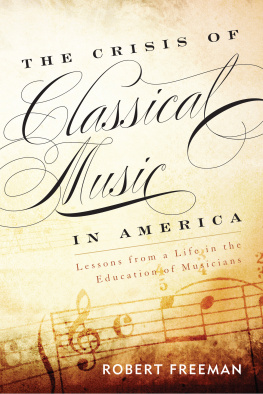

![Freeman - Pro design patterns in Swift: [learn how to apply classic design patterns to iOS app development using Swift]](/uploads/posts/book/201359/thumbs/freeman-pro-design-patterns-in-swift-learn-how.jpg)
